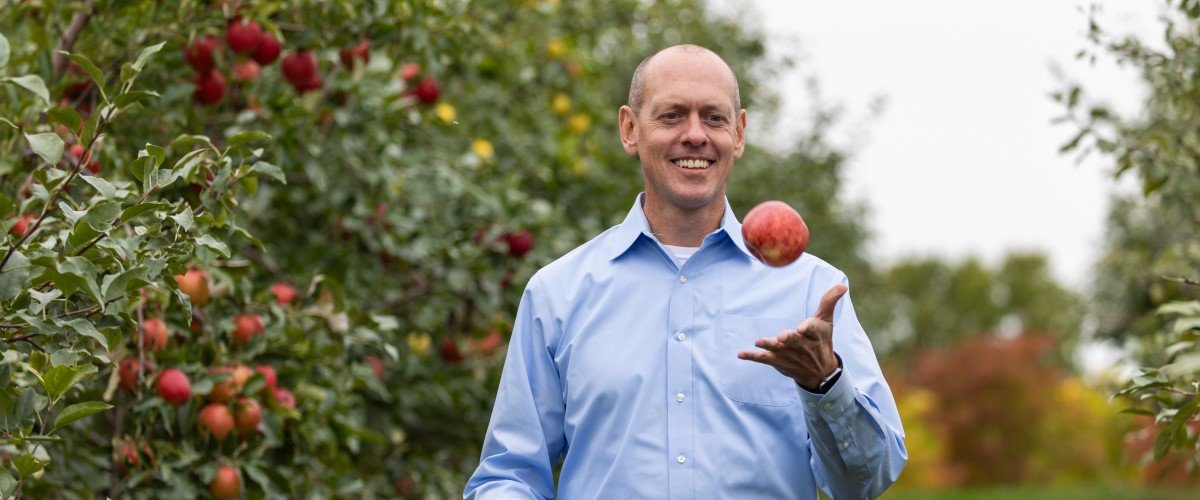
Career crossings
How Matt Clark’s pre-academic life and voracious desire to learn prepared him to take over one of the country’s leading fruit breeding programs

Plant breeding is a continuous experiment, endlessly crossing traits and categories with the aim of slowly and steadily improving the food we all depend on daily.
Nobody knows this better than Matt Clark, associate professor in the University of Minnesota’s Department of Horticultural Science, who recently took over leadership of a legendary fruit breeding program that has been making fruit hardier, tastier, and more accessible to Minnesotans for more than 150 years.
“Nearly every plant we eat today has come from a plant breeder who’s made improvements,” Clark said. “Plant breeding at its base is making crosses and selecting beneficial variations, then doing that over and over again.”
The process is highly meticulous and takes decades. A new variety of apple, for instance, typically takes about 25 to 30 years to bring to market. It requires incredible patience and dedication as a researcher — but the results are sweet. For example, the University’s fruit breeding program is responsible for developing the famously delicious Honeycrisp variety, a consumer favorite that was named the official state fruit in 2006.

Clark has very strong track records across research, teaching and service that put him in an excellent position to lead the fruit breeding program into the future. He has worked extensively in turfgrass, apples, and grapes during his 17 years at the University.
But just as importantly, he credits experiences outside academia — call them his cross-bred career traits — that have prepared him for his new role.
A foundation of diverse experiences
When Clark was growing up in northeast Iowa, his love of music led him to believe that one day he’d become a music teacher. In college, he explored different areas and eventually zeroed in on a degree in psychology.
After he finished his undergraduate degree, he worked for several years helping adults with disabilities. He was a job coach who worked with his clients and their support teams like family members, social workers and employers.
“That was really formative for thinking about how to solve problems as part of a team,” Clark reflected. “I grew up quickly learning how to communicate with small groups, formulate a plan and execute. I didn’t know it at the time, but those are valuable skills in science.”
One day, a friend told him about a weekend workshop learning how to graft apple trees — something he’d never dreamt could be a career. But within a week of taking the course, he had applied, interviewed and been accepted as a research assistant in the University’s Horticultural Sciences Department.
Eric Watkins, a professor of turf breeding and a vice provost for distributed learning, was Clark’s first advisor at the time.
“He was well prepared for graduate school. We could teach him the horticulture-specific knowledge. But he had these other skills and experiences that were very useful for him,” Watkins said.
And so, a new direction blossomed.
Increasing professional exploration
Over the years, Clark has overseen a wide variety of graduate work, developed cold-hardy grapes that have supported Minnesota’s flourishing wine industry and used his skills to rally teams around new avenues of research.
“Navigating everything available to plant breeders today is so exciting,” Clark said. “A plant breeder is inherently a generalist, looking at sensory attributes of the fruit, plant metabolomics, pests, soils and more. We need to collaborate broadly because there is no way I can be an expert in all those areas.”
Over the years, Clark has spent a good deal of time at the Minnesota Landscape Arboretum, whose 1,200 acres are home to the University’s Horticultural Research Center — the site of the fruit breeding program for more than 100 years.
It’s served as another source of cross-pollination for his career, since today he serves as the Arboretum’s director of research. He gets to assess and support research requests across a wide variety of species beyond just fruit – from helping protect ash trees against emerald ash borer to supporting conservation of Minnesota’s three native cactus species.
“Matt is an incredibly collaborative individual who is helping us move our institution forward and prepare for the future with a holistic vision for our research program,” said Andrew Gapinski, executive director at the Arboretum.
The ‘heyday’ of plant breeding
Given the time duration inherent in fruit breeding, researchers inevitably stand on the shoulders of those who came before them. Clark acknowledges the immense contributions of those who previously stewarded the fruit breeding program, like Professor James Luby who led it for more than 40 years until he recently retired.
And so, Clark also inevitably thinks about how he hopes to direct the program to set future researchers up for success.
That includes continuing to work on specific varieties of cold-hardy fruit like blackberries and seedless table grapes. And he wants to bring in new forms of computational research that take full advantage of the wide variety of genomes available today to help make future varieties more sustainable and resilient to climate change.
It also includes working to modernize the research facilities and infrastructure at both the University’s campus and the Arboretum.
To do this, Clark will lean on his well-cultivated trait of collaboration and his desire to keep evolving and learning.
“Our success is through working together to understand where the art and science of our field are going,” he said. “We are in the heyday of what plant breeding can be.”





